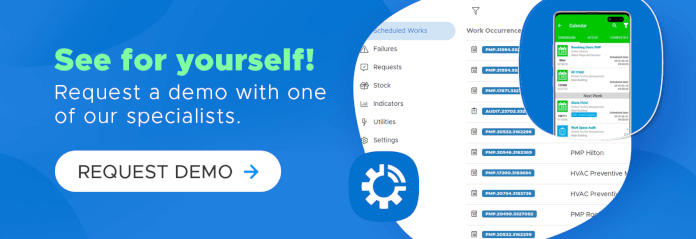If you landed on this page, you’ve probably heard about the benefits of reliability centred maintenance (RCM). However, in case you didn’t, here’s a brief recap.
Benefits of Reliability Centred Maintenance
- improving reliability (not a lot of surprises there!)
- increasing production capacity
- reducing maintenance costs
- delivering stable and sustainable reliability
Ready now? Let’s take a closer look at how to implement reliability centred maintenance at your company. And yes, RCM is be useful in any industry, not just in manufacturing or plant maintenance! The aviation industry, the military and even resorts apply it successfully.
Analyse your priorities
RCM prioritises function over everything else. Therefore, to implement reliability-centred maintenance, you need to assess which assets cannot fail to keep the system working. Generally speaking, those will be the most valuable pieces of equipment and/or the ones which cause the biggest losses when they break down.
Often, especially in plants, an RCM analysis is performed from the get-go. If this reminds you of an FMEA (which we’ll talk about later on), they are not the same thing. An RCM analysis addresses performance standards, while an FMEA identifies how a system can fail, and the consequences of those failures.
Define function
Let’s move on to the RCM assessment criteria. The first question is, “what are the functions and desired performance standards of each asset?”. For example, if we’re talking about a ventilation system, what is its desired capacity? How many air changes per hour should it make? If we’re talking about a production machine, what’s the desired output per hour? And so on.
After you determine its function, you’re ready to ask the second question: “how can each asset fail to fulfil its role?” In the case of our ventilation system, how can it fail to provide adequate ventilation? In the case of the machine, what can cause a functional breakdown – which could be stopping completely or producing defective parts?
Study failure modes
The third question is, “what are the failure modes for each functional breakdown?” If a lift stops mid-way, for example, it can be either a mechanical failure (failure mode 1) or an electrical one (failure mode 2). Okay, there are probably a few more failure modes, but you get the idea. This prompts several other questions.
But what causes each failure mode? Mechanical failures (failure mode 1) are most likely caused by lacklustre maintenance (we can develop this line of investigation and pinpoint something more specific, like misalignment). An electrical failure (failure mode 2) could be either lack of maintenance or a power cut, for example.
Insert Root Cause Analysis
Root-cause analysis is an indispensable resource at this point. Failure Mode and Effects Analysis (FMEA) is the best method to understand not only failure modes but also their effects and consequences. Note that there’s a difference between an effect and a consequence. An effect would be slowing down the machine, and the consequence could be delaying production. The worst consequence is, of course, halting production altogether.
If you’ve guessed that’s the fifth question, you’re right: what are the consequences of each failure mode? And, apart from FMEA and FMECA, there are other methods you can try. Instead of looking at an asset and describing each of its failure modes – which can be extremely time-consuming – work the other way around.
Look at your logs, spot failures that lead to loss of function, and ask “why did these failures happen”? Was it a human error, a mechanical or an electrical failure? What effects and consequences did they have? Our root-cause analysis guide also covers methods such as Fault-Tree Analysis (FTA), 5 Whys Analysis, Ishikawa diagrams and good old fashioned data analysis.
Choose the best strategy for each asset
Now that you’ve organised all the information you need about assets and their failure modes, what can be done to predict or prevent each failure? It’s easy to think preventive maintenance is the right method, but that’s not necessarily true. Remember that, according to RCM, the best strategy is the one that preserves the function of the whole system. Maintenance tasks should eliminate or detect failures before functionality is lost.
If that’s impossible, we should reduce the occurrence of failures or mitigate their consequences. That is why reliability engineers recommend predictive maintenance and condition monitoring (45-55%) over preventive maintenance (25-35%) and reactive maintenance (less than 10%). Occasionally, RCM also includes overhauling. A reliability program more than a glorified preventive maintenance plan.
⚙️ Struggling to decide what’s best for each asset? We’ll help you decide the right maintenance strategy with just four questions.
Review, restart and improve
RCM is a methodical approach. A reliability program is never truly over. Monitor your asset’s condition over time to assess reliability. You’ll need to monitor key performance indicators such as operating hours, the number of failures, and MTBF. If you review them periodically, we’re sure you will spot opportunities to improve.
And we’ve reached our final question: what should be done if a suitable proactive task cannot be determined? That’s another point where technology can make a difference. Let clients and staff report failures through Infraspeak Direct™ and react immediately. Use Infraspeak Gear™ to find a skilled technician and reduce your MTTR. And since you’re here, check out 8 ways to reduce downtime.
We know that was a lot to take in. But, as we’ve seen, you can implement reliability centred maintenance in just 5 steps:
- Analyse what compromises system function
- Define what function and functional failure consist of
- Study failure modes to understand what triggers them and their consequences
- Choose the right maintenance strategy to prevent or predict those failures
- Monitor and review


